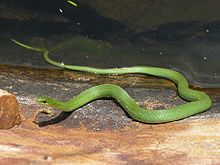- Smooth green snake
-
Smooth green snake 
A smooth green snake in Ontario Conservation status Scientific classification Kingdom: Animalia Phylum: Chordata Subphylum: Vertebrata Class: Reptilia Order: Squamata Suborder: Serpentes Family: Colubridae Subfamily: Colubrinae Genus: Opheodrys Species: O. vernalis Binomial name Opheodrys vernalis
(Harlan, 1827)Synonyms The smooth green snake (Opheodrys vernalis) is a non-venomous North American colubrid. It is also referred to as grass snake.
Contents
Description
The smooth green snake is slender.[2] Its size is classified as a "small medium" snake, reaching to 36–51 cm as an adult. The largest smooth green snake was measured as being 66 cm (26 in) long.[3] It is uniform light green on its back, with a yellow or white belly, and has smooth dorsal scales,[4] unlike those of the rough green snake. When a smooth green snake is first born, its scales are a different color than when it ages.[2] It can be olive green, blue-gray, or even brown when it is first born, and turn its characteristic green after its skin sheds for the first time. Typical for a non-venomous snake, its eyes are large and round. It uses its tongue, red with a black end, by flicking it in and out of its mouth to "smell" what is around it.[5]
Subspecies
- Eastern smooth green snake, Opheodrys vernalis vernalis (Harlan, 1827)
- Western smooth green snake, Opheodrys vernalis blanchardi Grobman, 1941
- Northern smooth green snake, Opheodrys vernalis borealis Grobman, 1992[6]
Geographic range
The smooth green snake has been found in areas across the northern half of the United States, as well as southern Canada. In the U.S., its range stretches from New England to Montana.[5]
Threats
It is hunted by a good amount of predators, including the red-tailed hawk, great blue heron, rough-legged buzzard, bears, raccoons, foxes, and the common house cat. Humans also find these snakes in the wild and keep them for pets.[7]
Conservation status
The snake is of least concern in terms of conservation, but the concern is increasing in the U.S.[8]
Habitat
The snake can be found in many different habitats, including marshes, meadows, the edges of streams, and open woods. It prefers to be on the ground, in opens areas without a lot of shrubs. During hibernation, the smooth green snake looks for burrows, ant hills, and other dug-out underground areas, normally gathering in large numbers.[2] It prefers moist habitats and areas near a permanent water source, usually staying in green areas for camouflage.[5][8]
Behavior
Smooth green snakes rely greatly on the environment for camouflage in order to protect themselves from predators. If threatened, a smooth green snake will usually flee. They are docile snakes, they seldom bite and they usually allow humans to come close.[8] If provoked, they can secrete a substance from its anal gland, causing a foul smell.[7] Smooth green snake eggs are white and oval. They have thin shells and tend to be about one inch in length.[5] When handled by humans, it usually shows exited behavior and calms down after wrapping itself around a finger. When it hunts, it turns its head from side to side, finding prey with its tongue and an organ on the roof of it's mouth that interprets chemical signals. It has no ears, relying on vibrations to figure out its surroundings. Also, the snake has no eyelids, but its sight is relatively strong over short distances. Due to stretchy ligaments in its jaw, it can swallow prey whole, even those that are larger than its own body diameter. It can shed its skin as often as every 4 to 5 weeks, allowing for growth.[7]
Diet
Smooth green snakes mostly eat insects and spiders. However, they will also eat millipedes, centipedes, salamanders, and slugs.[2]
Reproduction
The snake mates in the late spring or summer, laying its eggs sometime from June to September. Usually, two clutches are laid, each containing 4-6 eggs. Females usually lay their eggs in rodent burrows, mounds of rotting vegetation, sawdust piles, or rotting logs.[9] Smooth green snake eggs are white and oval. They have thin shells and tend to be about one inch in length.[5] The eggs tend to hatch 4-23 days after being laid.[9]
References
- ^ Cox, N., Chanson, J.S. & Stuart, S.N. (Global Reptile Assessment Coordinating Team) (2008). Liochlorophis vernalis. In: IUCN 2008. IUCN Red List of Threatened Species. Downloaded on 14 Oct 2008.
- ^ a b c d "Smooth green snake". Townson University. http://wwwnew.towson.edu/herpetology/reptiles/Opheodrys%20vernalis.htm. Retrieved 24 October 2011.
- ^ Conant 1975
- ^ Schmidt 1941
- ^ a b c d e "Northern Rockies Natural History Guide". The University of Montana. http://nhguide.dbs.umt.edu/index.php?c=reptiles&m=desc&id=11. Retrieved 21 November 2011.
- ^ Grobman, Arnold B. (1999). "Metamerism in the Snake Opheodrys vernalis, with a Description of a New Subspecies". Journal of Herpetology 26 (2): 175–186.
- ^ a b c Gregory, Adam. "Western Smooth Green Snake". South Dakota Department of Game, Fish and and Parks, Division of Wildlife, Pierre, SD. http://www3.northern.edu/natsource/REPTILES/Greens1.htm. Retrieved 22 November 2011.
- ^ a b c "The Illustrated Encyclopedia of North American Reptiles and Amphibians". Mobilereference. http://books.google.com/books?id=ue-TN0bHKw0C&pg=PT849&dq=Opheodrys+vernalis&hl=sv#v=onepage&q=Opheodrys%20vernalis&f=false. Retrieved 22 November 2011.
- ^ a b "Smooth Green Snake". UMassAmherst. http://www.umass.edu/nrec/snake_pit/pages/greens.html. Retrieved 21 November 2011.
Bibliography
- Conant, Roger (1975). A Field Guide to Reptiles and Amphibians of Eastern and Central North America (2nd ed.). Boston: Houghton Mifflin.
- Schmidt, K.P.; Davis, D.D. (1941). Field Book of Snakes of the United States and Canada. New York: G.P. Putnam's Sons.
- Wright, A.H.; Wright, D.D. (1957). Handbook of Snakes of the United States and Canada. Ithaca and London: Comstock.
External links
Categories:- IUCN Red List least concern species
- Colubrids
- Reptiles of North America
- Reptiles of the United States
- Fauna of Delaware and Maryland
- Reptiles of Ontario
- Animals described in 1827
Wikimedia Foundation. 2010.

